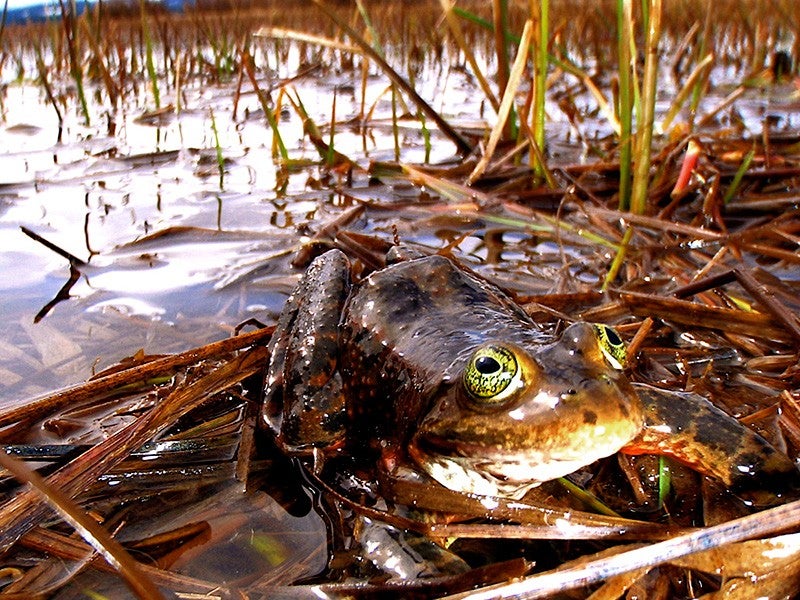Treating the Deschutes River Like an Irrigation Ditch Harms Rare Frogs and Fish
Dams and irrigation projects are jeopardizing some of the last remaining habitat for threatened Oregon spotted frogs, as well as salmon, steelhead and bull trout.

This page was published 9 years ago. Find the latest on Earthjustice’s work.
The Oregon spotted frog shows nature has a sense of humor or is at least artistic—it is a little frog, speckled with bright marks on its chest, gold-rimmed eyes and spots on its back that at times look like little black flowers. But despite its glitzy characteristics, the Oregon spotted frog is really hard to find—largely because human activity has mostly eliminated its home.
The species, Rana pretiosa, or “precious frog,” is the most aquatic frog native to the Pacific Northwest. It must be in or near water during all of its life stages, and it often hides in the muck of its river habitat. Once common from British Columbia to Northern California, the Oregon spotted frog has suffered a major population decline due to human development throughout the region. The way we have changed rivers in the west with dams and ditches and insatiable water use is a primary cause of the spotted frog’s decline. The Deschutes River in central Oregon is one of the few places where the frog still lives but human activity in the Deschutes is harming these last few frogs every season of every year. In August 2014, the U.S. Fish and Wildlife Service listed the species as threatened under the Endangered Species Act, and now Earthjustice is going to court to make sure Oregon leaves enough water flowing through the Deschutes every year for the frog to survive.
Oregon spotted frogs are indicators of a severely altered landscape. Dams and diversions throughout the Upper Deschutes River Basin alter the natural water flow such that artificially high flows occur between May and September and extremely low flows occur between October and April each year. When those changes are made they come very quickly—especially in the fall—with frogs and fish left high and dry in a matter of days. Wildlife agencies have documented dried-out egg masses every spring for the last several years, meaning entire generations of frogs are wiped out. The dramatic and unnatural swings in water flow damage the water quality and harm the habitat of the Oregon spotted frog, as well as the habitats of many native fish.
One of the most dramatic recent examples of the harm caused by extreme unnatural flow swings occurred in October 2013, when a rapid reduction in water flow caused by irrigation killed nearly 3,000 fish and sparked outrage throughout the state. In preparation for the next summer’s irrigation season, water was being retained to refill Crane Prairie and Wickiup Reservoirs. In the first two weeks of October of that year, river flows dropped from 500 to 34 cubic feet per second, leaving the fish literally out of water. Similar events have repeated this situation, requiring “bucket brigades” to save fish in the falls of 2014 and 2015. Unfortunately, little hard-to-find frogs can’t be tracked down and saved even with these extraordinary measures by citizen volunteers.
On January 11, 2016, Earthjustice filed suit in federal district court on behalf of WaterWatch of Oregon against the U.S. Bureau of Reclamation and several irrigation districts over harm caused by their water operations in the Upper Deschutes. The river conservation organization says that managing the Upper Deschutes like an irrigation ditch has caused significant damage to the river’s health, recreation and the economy of the region, and harm to the spotted frog, which is protected under federal law.
“The bureau has a responsibility to consult with the U.S. Fish and Wildlife Service to ensure its dam system management is not jeopardizing the survival of threatened wildlife and discontinue practices that are driving wildlife toward extinction,” said Janette Brimmer, an Earthjustice attorney representing WaterWatch. “Essentially, the law requires the bureau to follow the first rule of holes—when you are in one, stop digging.”
WaterWatch has worked with other stakeholders for decades in the Upper Deschutes River Basin to improve the use of water by irrigation districts, to restore stream flows and to reintroduce salmon and steelhead trout. The North Unit Irrigation District, for example, has enacted some good policies to conserve water and change or update the way they use it. Unfortunately, WaterWatch has been unable to convince most water users to change, including some in central Oregon who aren’t adequately conserving this precious resource.
As a major tributary of the Columbia River, the Deschutes River provides one of the finest streams for trout and salmon runs in North America. Yet despite the efforts of WaterWatch and other local conservation groups, there is still no law in Oregon to prevent private water users from completely draining a stream. Major water diversions have continued in order to meet the increasing water needs of central Oregon.
“The Upper Deschutes is a potential blue-ribbon trout stream, but is probably better known for fish kills because it is managed more like an irrigation canal than a river,” said John DeVoe, the executive director of WaterWatch of Oregon. “We can and must do better by this irreplaceable natural asset.”